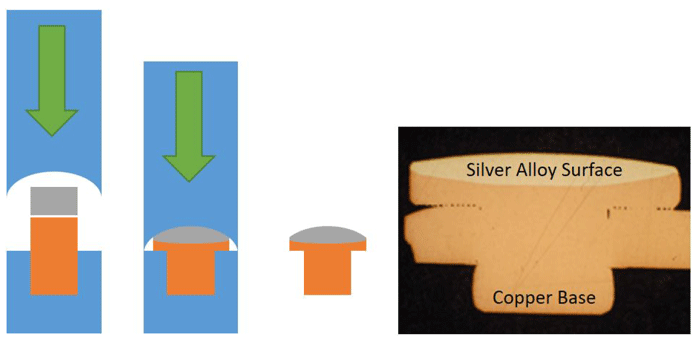Issue 008, March 11, 2021
Grant G. Justice, Research Metallurgist
Expanding on the previous discussion of material property measurements using tensile testing (DNI Tech Brief Issue 005), this article will discuss using those properties to aid in material selection for three example applications: low energy sliding contacts, bimetal rivets, and buckling beam test probes.
It should be noted that tensile properties are almost never the sole driver in material selection. Usually there are other key criteria that significantly narrow down the potential materials for an application. Once the short list of materials have been determined, then tensile properties will be used as one of the factors to further pare down this list of potential materials. For example, in a medical application, a key property is often biocompatibility, that would be used to make the initial material selection. Then, of the biocompatible materials, the one with the most favorable tensile properties for the application would be selected.
Sliding contacts are used for a range of low energy applications, including slip rings and precision variable resistors. The brushes require a small amount of tensile ductility to form the desired contact geometry at the end of the brush. In the case where a “knuckle” shape is desired, the large radius of curvature and the low thickness or diameter of the brush means that the elongation requirement is generally low. Once in operation, a key failure mode related to tensile performance is permanent deformation from a transient loading event bending the contact brush resulting in loss of contact in the assembly[1]. To minimize the risk of permanent deformation of the contact brush, it is desirable to have the largest elastic range possible. This is accomplished by selecting materials possessing a high yield strength in relation to their elastic modulus (i.e. maximizing σYS/E).
For a fixed elastic modulus, a higher yield strength allows a higher maximum load to be applied in the elastic regime, illustrated in Figure 1.

Figure 1: Effect of yield strength on potential range of brush deflection prior to plastic deformation.
Cold formed bimetal rivets are contacts with surfaces where a more expensive and higher performance material, often silver based, has been cold bonded to a lower cost material, usually copper or aluminum alloy (Figure 2). Material selection for the surface is primarily influenced by electrical performance requirements, and tensile properties primarily are used to select the lower cost mating material. The first tensile property requirement is often elongation: sufficient ductility must be present to support deformation during cold bonding. Additionally, matching the yield point and strain-hardening rates to ensure both materials deform at similar rates during the cold bonding process is key to establishing a strong bond and achieving the targeted final geometry[2].

Figure 2: Forming process and cross section of a Cu-Ag bimetal rivet.
Buckling beam probes are one of the many types of probes used to test semiconductor devices. The probes have three key design constraints related to tensile performance: maintain a consistent load over a wide range of overdrive, minimize wear on the probe tip, and avoid permanent deformation during operation. Maintaining constant load over a wide range of overdrives is achieved by operating the probe under buckling (Figure 3), where key factors affecting the load are the shape of the cross section, the elastic modulus of the material, and the mechanical fixturing of the probe. Tip wear is a complex process involving mechanical, chemical, and thermal criteria, however, materials with higher yield and ultimate tensile strengths, and corresponding higher hardness, tend to experience lower wear rates. Finally, the probes must not permanently deform during operation. Operation of the probes is usually at a high current density, resulting in resistive heating of the probe. As a result, failure is often mediated by elevated temperatures[3]. Survivability may be evaluated by a combination of stress relaxation measurement, hardness testing after prolonged elevated temperature exposure, and hot tensile testing.

Figure 3: Schematic of a buckling beam probe used for semiconductor device testing.
The final selection of material for any application will depend on a combination of material properties. While many of the key properties are application specific, tensile performance is distinctive due to its ubiquity in the materials selection process across all applications. Understanding how tensile properties will affect the performance of the final part is key to successful material selection.
References:
[1] Pitney KE. General Contact Theory. In: Ney Contact Manual: Electrical Contacts for Low Energy Uses. Bloomfield, Connecticut:
The J.M. Ney Company; 1973. p. 99-154.
[2] Mori, Ken-ichiro, et al. “Joining by plastic deformation.” CIRP Annals 62.2 (2013): 673-694.
https://www.sciencedirect.com/science/article/abs/pii/S0007850613001947
[3] Daniels EB. ISMI Probe Council: Current Carrying Capability Measurement Standard. In San Diego, CA, USA; 2009. Available
from https://www.swtest.org/swtw_library/2009proc/PDF/S08_03_Daniels_SWTW2009.pdf
